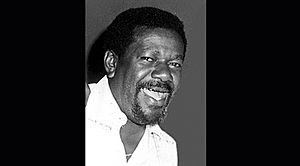Rafael Cortijo facts for kids
Quick facts for kids
Rafael Antonio Cortijo
|
|
|---|---|
 |
|
| Background information | |
| Born | December 11, 1928 Santurce, Puerto Rico |
| Died | October 3, 1982 (aged 54) Santurce, Puerto Rico |
| Genres | Salsa |
| Occupation(s) | Musician, bandleader, composer |
| Instruments | Percussion |
| Years active | 1940–1982 |
| Labels |
|
Rafael Antonio Cortijo (born December 11, 1928 – died October 3, 1982) was a famous Puerto Rican musician, band leader, and composer. He was also skilled at making percussion instruments. Cortijo is remembered for his exciting music and for leading popular bands that brought joy to many.
Contents
Cortijo's Early Musical Journey
As a child, Cortijo loved Caribbean music. He especially enjoyed the sounds of Bomba y Plena music, which uses special drums. He even learned how to make his own congas and pleneras, which are types of handheld drums.
Cortijo grew up in the Villa Palmeras neighborhood of Santurce, Puerto Rico. There, he met Ismael Rivera, who would become a lifelong friend and a famous salsa singer. Rivera was very impressed by Cortijo's drumming skills. Cortijo invited Rivera to join his orchestra, and they performed at many local festivals across Puerto Rico.
Becoming a Music Star
Rafael Cortijo's big break came in 1954. He joined a group called "El Combo" with pianist Rafael Ithier. The leader of "El Combo" left the band, and Cortijo took over.
In 1955, Ismael Rivera joined Cortijo's new orchestra, which became known as Cortijo y su Combo. This group became very popular! From 1955 to 1960, they performed live on Puerto Rican television shows. They even became the house band for a show called La Taberna India.
Later, Cortijo formed another orchestra called "El Bonche." His adopted niece, Fe Cortijo, joined this group and later became a well-known singer herself.
Cortijo y su Combo: The Famous Band
In 1954, Cortijo y su Combo had many talented musicians:
- Rafael Ithier played the piano.
- Cortijo played the timbal (a type of drum).
- Roberto Roena played the bongo drums.
- Martín Quiñones played the congas.
- Eddie Pérez and Ismael Rivera were the singers.
- Miguel Cruz played the bass.
- Kiko Vélez and Mario Cora played the trumpet.
This band had a fresh, new sound that made their music best-sellers. They also made history by being an all-black group that appeared often on television. This was a big deal at the time and helped challenge old ideas. They were featured on popular shows like La Taberna India and El show del Mediodía.
Ismael Rivera sang many famous songs with Cortijo y su Combo, including:
- "El Bombón de Elena"
- "El Negro Bembón"
- "Juan José"
- "Besitos de Coco"
- "Palo Que Tú Me Das"
- "Quítate de la Vía Perico"
- "Oriza"
- "El Chivo de la Campana"
- "Maquinolandera"
- "El Yayo"
- "María Teresa"
- "Yo Soy del Campo"
You can listen to some of their music:
In 1962, the band faced a challenge when Ismael Rivera had to leave the group. After this, Rafael Ithier and other band members went on to create another very famous salsa group called "El Gran Combo".
In 1974, many of the original members of "Cortijo y su Combo" reunited for a special concert and recorded a new album. Rafael Cortijo became well-known across Latin America. He believed his success came from the unique sound of his percussion instruments and the Afro-Caribbean music style.
Later Years and Legacy
Cortijo later moved to New York City. He then returned to Puerto Rico, where a composer named Tite Curet Alonso helped him create a comeback album.
Rafael Cortijo passed away on October 3, 1982, in Santurce, Puerto Rico. He was buried at Cementerio San José in San Juan, Puerto Rico. His music continues to be loved and remembered by many.
See also
 In Spanish: Rafael Cortijo para niños
In Spanish: Rafael Cortijo para niños

